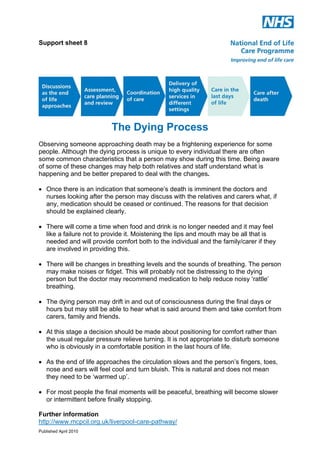Support Sheet 8: The Dying Process
•
0 gostou•956 visualizações
Support Sheet 8: The Dying Process This support sheet describes some of the common characteristics of the dying process.
Denunciar
Compartilhar
Denunciar
Compartilhar
Baixar para ler offline

Recomendados
Mais conteúdo relacionado
Mais procurados
Mais procurados (20)
Aralin 27 - Papel ng Sektor ng Industriya sa Kaunlaran

Aralin 27 - Papel ng Sektor ng Industriya sa Kaunlaran
Applied economics introduction to economics abm specialized subject

Applied economics introduction to economics abm specialized subject
Mga salik na nakakaapekto sa pangangailangan at kagustuhan

Mga salik na nakakaapekto sa pangangailangan at kagustuhan
Semelhante a Support Sheet 8: The Dying Process
Semelhante a Support Sheet 8: The Dying Process (20)
Global Medical Cures™ | End of Life- Helping with Comfort & Care

Global Medical Cures™ | End of Life- Helping with Comfort & Care
END OF LIFE CARE- all ages deserve quality end of life care

END OF LIFE CARE- all ages deserve quality end of life care
Challenges Of Stroke Survivors & Their Family2 Feb2106

Challenges Of Stroke Survivors & Their Family2 Feb2106
Coping with Challenging Behaviors in Dementia Care and Successful Staff Appro...

Coping with Challenging Behaviors in Dementia Care and Successful Staff Appro...
Mais de NHS IQ legacy organisations
Support Sheet 14: Using the NHS Continuing Health Care Fast Track Pathway Tool

Support Sheet 14: Using the NHS Continuing Health Care Fast Track Pathway ToolNHS IQ legacy organisations
Mais de NHS IQ legacy organisations (20)
Creating the culture for innovation - A guide for executives

Creating the culture for innovation - A guide for executives
The handbook of quality and service improvement tools 2010

The handbook of quality and service improvement tools 2010
Support Sheet 15: Enhancing the Healing Environment

Support Sheet 15: Enhancing the Healing Environment
Support Sheet 14: Using the NHS Continuing Health Care Fast Track Pathway Tool

Support Sheet 14: Using the NHS Continuing Health Care Fast Track Pathway Tool
Support Sheet 13: Decisions made in a person's 'Best Interests'

Support Sheet 13: Decisions made in a person's 'Best Interests'
Support Sheet 11: Quality Markers for Acute Hospitals

Support Sheet 11: Quality Markers for Acute Hospitals
Support Sheet 8: The Dying Process
- 1. Support sheet 8 The Dying Process Observing someone approaching death may be a frightening experience for some people. Although the dying process is unique to every individual there are often some common characteristics that a person may show during this time. Being aware of some of these changes may help both relatives and staff understand what is happening and be better prepared to deal with the changes. ! Once there is an indication that someone’s death is imminent the doctors and nurses looking after the person may discuss with the relatives and carers what, if any, medication should be ceased or continued. The reasons for that decision should be explained clearly. ! There will come a time when food and drink is no longer needed and it may feel like a failure not to provide it. Moistening the lips and mouth may be all that is needed and will provide comfort both to the individual and the family/carer if they are involved in providing this. ! There will be changes in breathing levels and the sounds of breathing. The person may make noises or fidget. This will probably not be distressing to the dying person but the doctor may recommend medication to help reduce noisy ‘rattle’ breathing. ! The dying person may drift in and out of consciousness during the final days or hours but may still be able to hear what is said around them and take comfort from carers, family and friends. ! At this stage a decision should be made about positioning for comfort rather than the usual regular pressure relieve turning. It is not appropriate to disturb someone who is obviously in a comfortable position in the last hours of life. ! As the end of life approaches the circulation slows and the person’s fingers, toes, nose and ears will feel cool and turn bluish. This is natural and does not mean they need to be ‘warmed up’. ! For most people the final moments will be peaceful, breathing will become slower or intermittent before finally stopping. Further information http://www.mcpcil.org.uk/liverpool-care-pathway/ Published April 2010